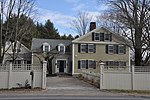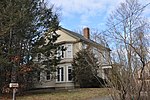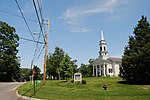Sewall–Ware House
Houses in Sherborn, MassachusettsHouses on the National Register of Historic Places in Middlesex County, MassachusettsMiddlesex County, Massachusetts Registered Historic Place stubsNational Register of Historic Places in Middlesex County, Massachusetts
The Sewall–Ware House was a historic house at 100 S. Main Street in Sherborn, Massachusetts. The house stood on land once belonging to Massachusetts judge Samuel Sewall (best known for his participation in the Salem witch trials). The house may have been constructed by Sewall's instructions for a tenant farmer. In the mid-18th century it was the boyhood home of Harvard College divinity professor Henry Ware, and remained in the Ware family well into the 19th century. It was added to the National Register of Historic Places in 1986. The house no longer stands at the location described in the listing papers, and has probably been demolished.
Excerpt from the Wikipedia article Sewall–Ware House (License: CC BY-SA 3.0, Authors).Sewall–Ware House
South Main Street,
Geographical coordinates (GPS) Address Nearby Places Show on map
Geographical coordinates (GPS)
| Latitude | Longitude |
|---|---|
| N 42.228611111111 ° | E -71.367222222222 ° |
Address
South Main Street 96
01770
Massachusetts, United States
Open on Google Maps











